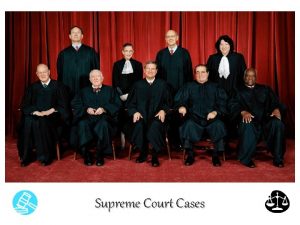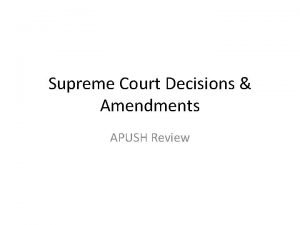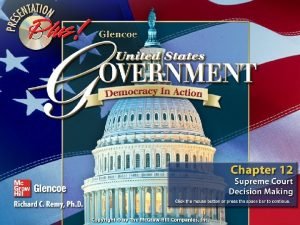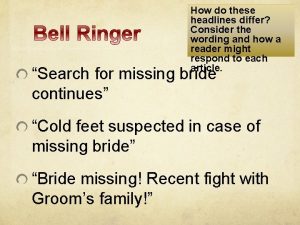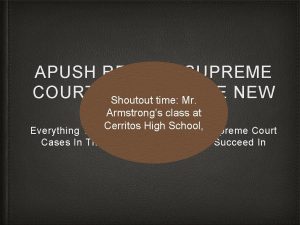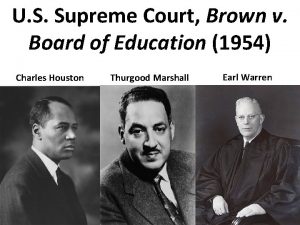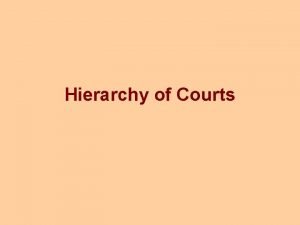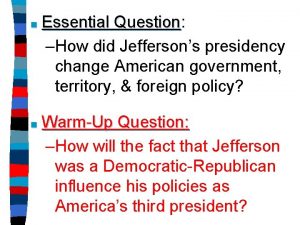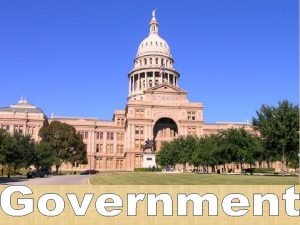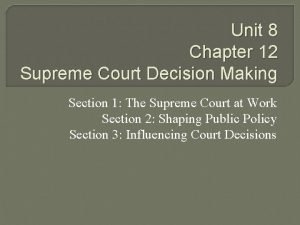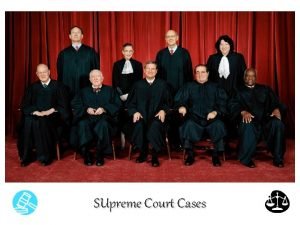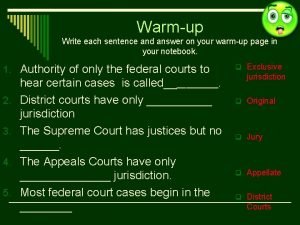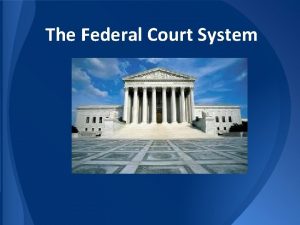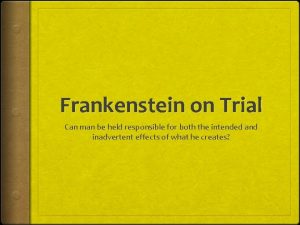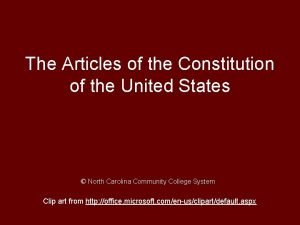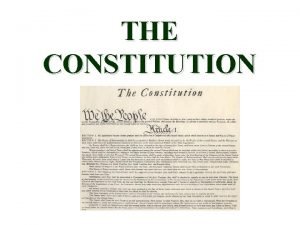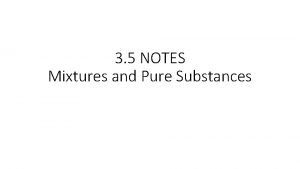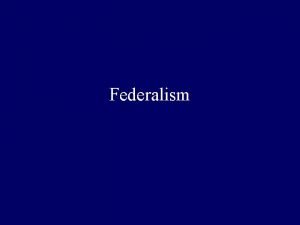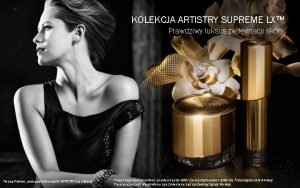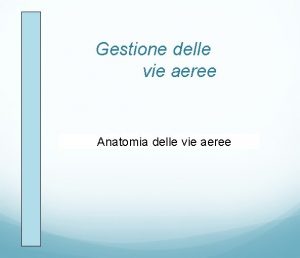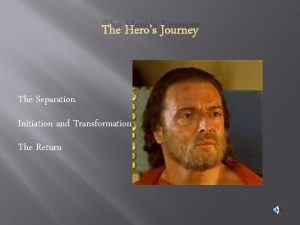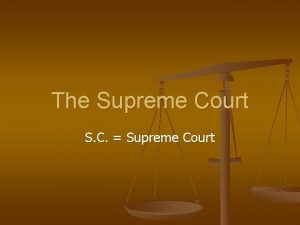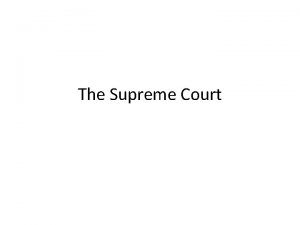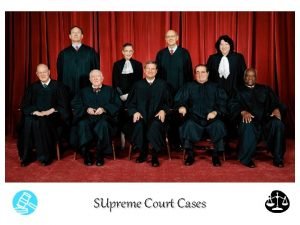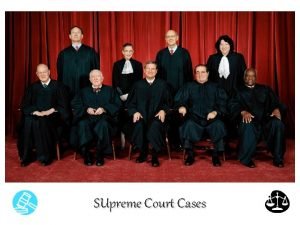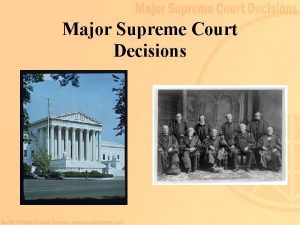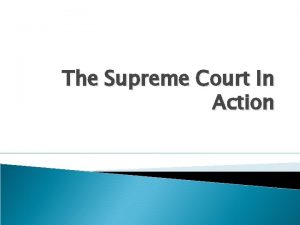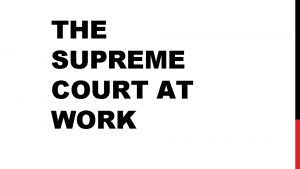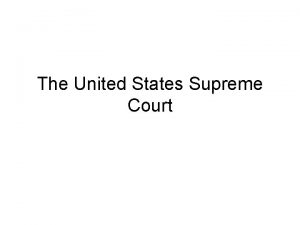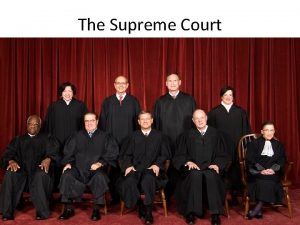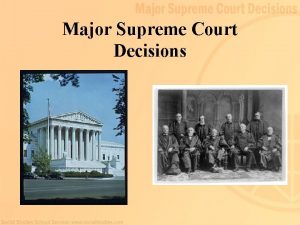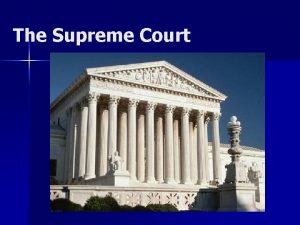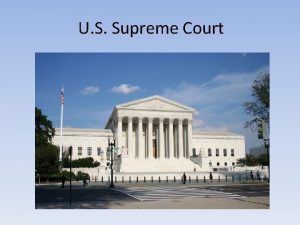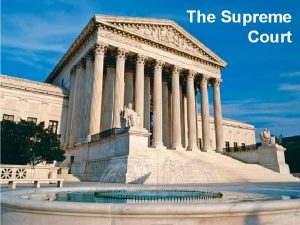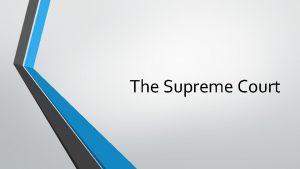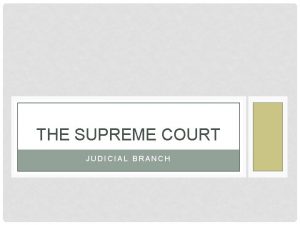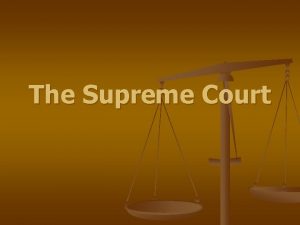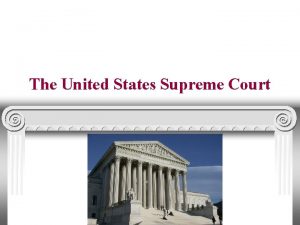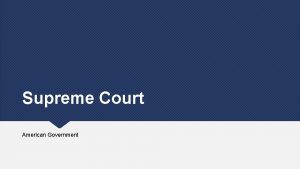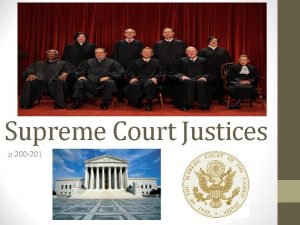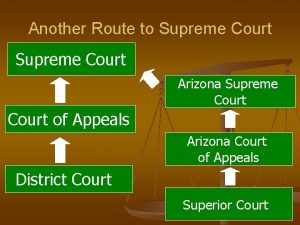LEQ What Supreme Court Case gave the court







































































- Slides: 71

LEQ: What Supreme Court Case gave the court more power than it ever had before? This image is an inscription on the wall of the United States Supreme Court Building. It is a quote from Chief Justice John Marshall, who outlined the concept of judicial review. This image is courtesy of Wikimedia Commons.

LEQ: What Supreme Court Case gave the court more power than it ever had before? Marbury v. Madison This image is an inscription on the wall of the United States Supreme Court Building. It is a quote from Chief Justice John Marshall, who outlined the concept of judicial review. This image is courtesy of Wikimedia Commons.

The Age of Jefferson Begins This painting shows Thomas Jefferson in his office in the White House in 1803. Standing before him is his personal secretary, Meriwether Lewis. A bird is flying around the room. This image is titled A Bird That Whistles. It was painted by Peter Waddell. This room later became the State Dining Room. This image is courtesy of the White House Historical Association.

LEQ: What Supreme Court Case gave the court more power than it ever had before? This image is an inscription on the wall of the United States Supreme Court Building. It is a quote from Chief Justice John Marshall, who outlined the concept of judicial review. This image is courtesy of Wikimedia Commons.

LEQ: What Supreme Court Case gave the court more power than it ever had before? Marbury v. Madison This image is an inscription on the wall of the United States Supreme Court Building. It is a quote from Chief Justice John Marshall, who outlined the concept of judicial review. This image is courtesy of Wikimedia Commons.

Thomas Jefferson was talented in many ways. As one of the country’s best architects, he designed the buildings of the University of Virginia… This image shows “The Lawn” at the University of Virginia. This area was designed by Thomas Jefferson as his “Academical Village. ” The building with the dome, known as The Rotunda was originally the University Library. On the sides are located 10 Pavilions, where faculty reside in the upper two floors and teach on the first, as well as 54 Lawn rooms, where carefully selected undergraduates reside in their final year. This image is courtesy of Wikimedia Commons.

…the Virginia State Capitol… The Virginia State Capitol, located in Richmond, Virginia was completed in 1788 and originally did not have the wings shown in this image. The wings were added early in the 1900 s. This image was created in 1790. This image is courtesy of Wikimedia Commons.

…and his own home at Monticello. This is the front… Construction first began on Monticello in 1769, and it was completed circa 1772. The upper story was demolished in 1796, and it was completed to its present configuration in 1809. Monticello has been maintained and kept open to the public by the Thomas Jefferson Foundation since 1923. The Foundation owns approximately 2500 acres of Jefferson’s 5000 acre plantation. This image is courtesy of monticello. org.

…and this is the back of Monticello, which was also the design on the back of the United States nickel. Monticello has been featured on the reverse of the United States nickel from 1938 to the present, with a brief interruption from 2004 -2005 when designs of the Westward Journey series appeared instead. Monticello was also featured on the reverse of the two-dollar bill from 1928 -1966. , and on a postage stamp in 1956. This image is courtesy of Wikimedia Commons.

Jefferson was also a good musician, and he enjoyed playing the violin. This image shows a violin that belonged to Thomas Jefferson. Documentation shows that during his lifetime, he possessed at least three violins. This image is courtesy of exploresteamboat. com.

He was a gardener, he spoke many languages, and he was an inspiring writer. This image shows Thomas Jefferson’s vegetable garden at his home at Monticello, near Charlottesville, Virginia. This image is courtesy of Wikimedia Commons.

He was also a lawyer, a Governor of Virginia, the First Secretary of State, a Vice President, and the third President of the United States. Thomas Jefferson (1743 -1826) was a Founding Father of the United States, the author of the Declaration of Independence, the United States Minister to France, and the founder of the University of Virginia. This painting was created by Rembrandt Peale (1778 -1860) in 1800. This image is courtesy of the White House Historical Association.

In a letter to a fellow Democratic Republican two days after he was inaugurated, Jefferson referred to his election victory as the “revolution of 1800… “… as real a revolution in the principles of our government as that of 1776 was in form. ” This painting was created by Gilbert Stuart (1755 -1828) in 1805. This image is courtesy of Wikimedia Commons.

By using the word revolution, Jefferson meant that the American people had voted for changes as great as those they had fought for in the Revolutionary War. This image shows the surrender of the British at Yorktown, Virginia on October 19, 1781. British General Charles O’Hara is surrendering to American General Benjamin Lincoln who is mounted on the white horse and is gesturing for O’Hara’s sword. This painting was crated by John Trumbull (1756 -1843) in 1820. It was placed in the Rotunda of the United States Capitol in 1826. This image is courtesy of the Architect of the Capitol.

The peaceful revolution of 1800 proved to the world that the young republic could make political changes without violence-- something very unusual at the time. This image shows the tally of electoral votes for the Presidential election of 1800. Thomas Jefferson and Aaron Burr each received 73 electoral votes. After five days and 35 ballots of voting in the House of Representatives, Jefferson was declared to be the Third President of the United States. This image is courtesy of the National Archives.

This was the first time in modern history that the political control of a country passed from one political party to another through a democratic election. This is an artist’s conception of Thomas Jefferson arriving for his inauguration at the United States Capitol in 1801. Other sources state that he walked to the Capitol. This image is courtesy of the Library of Congress.

After Jefferson tied up his horse outside the Capitol he walked towards the camera and through the original entrance to the United States Senate. The original entrance to the United States Senate Chamber at the Capitol was through the doors closest to the camera. The extension of the Capitol began in 1958, added 32 feet 6 inches to the East Front. The extension project was completed in 1962. This photograph was taken by Robert Housch on November 4, 2015.

After entering the front door of the Capitol, he took a right (north) and entered the original Senate Chamber in the Capitol, which is now the Old Supreme Court Chamber. This area is known as the Old Senate Vestibule. The Senate Vestibule is known for its distinct “corncob capitals” atop the columns. This photograph was taken by Robert Housch on November 9, 2016.

When Thomas Jefferson was inaugurated, he was sworn into office in the room located here, which again was the first United States Senate Chamber, and later became the Old Supreme Court Chamber. When Jefferson was inaugurated, the ceiling was much higher, and not the ceiling that is located there today. Later the taller room was divided in half with the Senate on the top floor and the Supreme Court located here on the bottom level. This image was taken by Robert Housch on February 24, 2016.

Thomas Jefferson became the first President to take the oath of office in the new capital of Washington, D. C. Jefferson’s inauguration took place on March 4, 1801. This image is courtesy of the Library of Congress.

Jefferson was sworn in by Chief Justice John Marshall, a Federalist who was one of John Adams’ last appointees. John James Marshall (1755 -1835) was the fourth Chief Justice of the United States. He served as Chief Justice during all or part of the administrations of six Presidents. He participated in over 1000 decisions, and wrote 519 of the opinions. This painting was created by Henry Inman (1801 -1846) in 1832. This image is courtesy of Wikimedia Commons.

At the time of Jefferson’s inauguration, Washington, D. C. was still unfinished. This is a black and white engraving published in 1834 to portray Washington, D. C. and the west front of the U. S. Capitol grounds as they looked in 1800. The street is Pennsylvania Avenue. The poplar trees were not planted until 1803. This image is courtesy of the Library of Congress.

The capital’s streets were unpaved, and few buildings were completed. This painting shows the east front of the United States Capitol when Congress began to occupy it in 1800. This image was crated by William Birch (1755 -1834) circa 1800. This image is courtesy of the Library of Congress.

Jefferson believed the people were the source of a government’s power. The change in leadership brought great political and philosophical change to the presidency. This is an image of Thomas Jefferson’s First Inaugural Address. This image is courtesy of the Library of Congress.

Jefferson wanted to make government more democratic, providing more people with equal rights. Of course Jefferson was a white male slaveholder who was not advocating equal rights for women and/or African Americans. This image is titled The County Election by George Caleb Bingham (1811 -1879). The painting was completed in 1852. This image is courtesy of Wikimedia Commons.

Jefferson wanted national harmony after his bitter election with Adams. He encouraged all citizens to work together, stating: This patriotic engraving was created in 1799. It shows the sixteen states then in the union surrounding President John Adams. Below each state’s seal are its population and the number of senators and representatives. Over the top if the defiant motto, “Millions for our defense Not a Cent for Tribute, ” a slogan that became popular during the Quasi War with France. This image was featured in Amos Doolittle’s A New Display of the United States. This image is courtesy of the Library of Congress.

“All, too, will bear in mind this sacred principle… that the minority possess their equal rights, which equal law must protect…” When Thomas Jefferson was inaugurated, he was sworn into office in this room, the first United States Senate Chamber, which later became the Old Supreme Court Chamber. This photograph was taken by Robert Housch on November 2, 2016.

“Let us, then, follow-citizens, unite with one heart and one mind… We are all Republicans, we are all Federalists. ” By this statement, he recognized that despite the Federalists distrust of Jefferson’s democratic ideas. . This image is courtesy of emersonkent. com.

…Federalists recognized that political problems are finally settled by the will of the people. The Federalists did not have a known logo or symbol in 1796. A symbol for the Federalists became the black and white cockade shown here. A black cockade became a symbol for the Federalist party in 1798 when it appeared that we would go to war against France had red white and blue cockades. This was the anti-French cockade. This image is courtesy of Wikimedia Commons.

Also, despite their distrust of centralized power, the Democrat. Republicans did not propose to destroy the federal government. The symbol for the Democratic-Republicans, later the Democrats, became the donkey, here shown being ridden by Andrew Jackson. This was one of the first times the donkey was used in a political cartoon. When Jackson ran for President in 1828 his opponents tried to label him a “jackass” for his populist views and his slogan, “Let the people rule. ” Jackson put the donkey on some of his campaign posters. This image is courtesy of the Library of Congress.

Federalists supported a strong central government and rule by an elite, or a wealthier, better-educated, small class of people. Jefferson believed in states’ rights and rule by the majority. This image shows Rudulph Evans’ (1878 -1960) statue of Thomas Jefferson located in the Jefferson Memorial in Washington, D. C. On the right is the Declaration of Independence. This image is courtesy of Wikimedia Commons.

Jefferson thought state governments were closer to the people than the national government. This image shows the Virginia State Capitol, located in Richmond, Virginia. It was designed by Thomas Jefferson. This image was taken in 1865. This image is courtesy of the Library of Congress.

Alexander Hamilton believed that the government should actively promote banking, commerce, and industry. Alexander Hamilton (1757 -1804) was the first Secretary of the Treasury of the United States. This painting was created in 1806 by John Trumbull (1756 -1843). This image is courtesy of the Washington University Law School and of Wikimedia Commons.

Jefferson advocated a hands-off policy in business called laissez-faire. Laissez-faire is a French term which means “let things alone, ” or “let the people do as they choose. ” Jefferson once wrote, “the issuing power should be taken from the banks, and restored to the people to whom it properly belongs. ” This image is courtesy of the Library of Congress.

Jefferson and the Republicans believed the federal government’s role should be to keep people from injuring each other. Jefferson believed that the citizens should be “free to regulate their own pursuits. ” This image shows Vermont Congressman Matthew Lyon and Connecticut Congressman Roger Griswold fighting on the floor of the House of Representatives in Philadelphia in 1798. This image is courtesy of the Library of Congress.

Besides limiting the power of the federal government, Jefferson wanted to cut the federal budget and lower taxes. Jefferson wanted “a wise and frugal government. ” This image shows the Capitol building in 1800. Only the north side (current Senate wing) had been completed. This painting was completed by Allyn Cox (1896 -1982) circa 1973. It is located in the Eastern North-South Corridor in the United States Capitol, which is now called the “Hall of Capitols. ” This image is courtesy of the Architect of the Capitol.

When George Washington was President, Jefferson had opposed many of Alexander Hamilton’s economic plans. George Washington (seated on the right) is shown with his two of his most important cabinet officers, Thomas Jefferson, the Secretary of State (seated on the left), and Alexander Hamilton, the Secretary of the Treasury (standing). Knowing Jefferson was discontented, Washington wrote him this note: “I believe the views of both of you to be pure and well-meant… I have a great sincere esteem and regard for you both, and ardently wish that some line could be marked out by which both [of] you could walk. ” This image is courtesy of alaynacsapushblogspot. com.

As President, though, Jefferson did promise to pay off the national debt, encourage agriculture and trade, and preserve the country’s credit. When Jefferson took office, the national debt was approximately $83 million. This image is courtesy of genopp. tumblr. com.

To help cut spending, Jefferson appointed Albert Gallatin as the Secretary of the Treasury. Albert Gallatin (1761 -1849) was an immigrant from Switzerland who lived in western Pennsylvania. He was considered to be a brilliant financier who had been an outstanding member of the House of Representatives. This painting was created by Rembrandt Peale (1778 -1860) in 1805. This image is courtesy of explorepahistory. com.

Gallatin worked to simplify government and to avoid the high costs of war and defense. Gallatin and Jefferson greatly cut military spending. They cut the army from 4000 to 2500 men and made similar cuts in the number of sailors and naval officers. This image shows the Albert Gallatin statue outside the United States Treasury Building in Washington, D. C. This image is courtesy of Wikimedia Commons.

During Jefferson’s administration, the U. S. Navy went from 25 ships to only 7 ships. The U. S. S. Chesapeake served in the United States Navy from 1800 -1813. She was a 36 -gun frigate built in Portsmouth, Virginia. This image was painted by William F. Muller in the early 1900 s. This image is courtesy of history. navy. mil.

Gallatin also cut the staff of the executive branch to reduce government spending. These measures together helped cut the national debt from $83 million to about $45 million. This image shows the Marine Guard at the White House circa 1801. This image is courtesy of Wikimedia Commons.

Though Jefferson had opposed the formation of a national bank, Gallatin convinced him to keep the Bank of the United States as it was. This image shows the First Bank of the United States located at 116 South 3 rd Street in Philadelphia, Pennsylvania. The First Bank of the United States was in existence from 1797 -1811. This image is courtesy of Wikimedia Commons.

LEQ: What Supreme Court Case gave the court more power than it ever had before? This image is an inscription on the wall of the United States Supreme Court Building. It is a quote from Chief Justice John Marshall, who outlined the concept of judicial review. This image is courtesy of Wikimedia Commons.

LEQ: What Supreme Court Case gave the court more power than it ever had before? Marbury v. Madison This image is an inscription on the wall of the United States Supreme Court Building. It is a quote from Chief Justice John Marshall, who outlined the concept of judicial review. This image is courtesy of Wikimedia Commons.

Because of the money that was saved by the cuts to the federal government’s budget, Jefferson and the Congress repealed the unpopular excise taxes on whiskey and other products. They ended all internal taxes. This painting shows President George Washington reviewing troops in Cumberland, Maryland in 1795 before they march west to suppress the Whiskey Rebellion in western Pennsylvania. This image is courtesy of Wikimedia Commons.

The federal government’s only sources of money were now tariffs on imports and revenue from the sale of Western lands. This image is a diagram of the Land Ordinance of 1785. It shows the method of subdividing can be applied to a single lot. This image is courtesy of Wikimedia Commons.

Proudly, Jefferson said that the money made from tariffs and selling western lands would be great enough to pay for roads, education, arts, and other public works. This image shows workers constructing a section of the National Road in Ohio. This image is courtesy of the National Park Service.

Jefferson pointed out that it was the pride and pleasure of an American to ask, “what farmer, what mechanic, what laborer, ever sees a tax collector…? ” This image of a tax collector during the Whiskey Rebellion of 1795 was created in 1880 for R. M. Devns’ Our First Century: Being a Popular Descriptive Portraiture of the One Hundred Great And Memorable Events of Perpetual Interest in the History of Our Country. This image is courtesy of Wikimedia Commons.

The Alien and Sedition acts started by the Federalists expired at the end of 1801, and Jefferson did not renew them. Instead, he pardoned those who had been convicted under the acts, even refunding the fines that had been paid. Congress passed a new naturalization act. This is an image of the Alien Act passed in 1797. This image is courtesy of the National Archives.

The new naturalization act went back to the 5 -year residency requirement for citizenship, instead of the 14 years required by the Alien Acts. This image is titled “Emigrants leaving Ireland. ” This image was created by Henry Edward Doyle (1827 -1892) for Mary Frances Cusack’s An Illustrated History of Ireland from A. D. 400 to 1800. This image is courtesy of Wikimedia Commons.

The Democratic-Republicans had gained control of Congress and the presidency in 1800. Between the election in November and Jefferson’s inauguration in March, Federalists in Congress passed the Judiciary Act of 1801. This image is courtesy of Wikimedia Commons.

The Judiciary Act of 1801 increased the number of federal judges. Outgoing President John Adams then filled many positions with members of his own party. Supreme Court Justices are each responsible for a different federal district in the United States. During the time of Thomas Jefferson, Supreme Court Justices had to “ride circuit” in their districts and hear cases. This image shows Chief Justice John Marshall talking with patrons in a tavern while he was riding circuit. This image is courtesy of supremecourthistory. org.

The judges appointed by Adams were known as “Midnight Judges” because Adams supposedly signed appointments for judges until midnight on his last day in office. Following his 1800 defeat, Adams retired into private life. Depressed when he left office, he did not attend Jefferson's inauguration, making him one of only four surviving presidents not to attend his successor's inauguration. This image engraved from a painting by Alonzo Chappel. It was published in Evert Augustus Duyckinck’s The National Portrait Gallery of Eminent Americans, in 1856.

Democratic Republicans argued that this method of packing the courts with Federalists was unfair. One of the first acts of Congress after Jefferson took office was to repeal the Judiciary Act. This image shows the Old Supreme Court Chamber. This image is courtesy of senate. gov.

After doing away with the midnight judges by abolishing their positions, the Republicans tried to remove other Federalist judges by impeachment. This image shows the impeachment trial of President Andrew Johnson in the United States Senate Chamber in 1868. This image is courtesy of senate. gov.

Impeachment means bringing charges of wrongdoing against a public official. This image shows United States Congressman Thaddeus Stevens from Pennsylvania reads charges of wrongdoing in the House of Representatives during the impeachment of President Andrew Johnson in 1868. This image is courtesy of history. com.

According to the Constitution, a majority of the House of Representatives can vote to bring such charges against any government official. This painting shows an evening session of the United States House of Representatives in the old House Chamber, now known as Statuary Hall. This painting was created by Samuel F. B. Morse (1791 -1872) in 1823. This image is courtesy of the Library of Congress.

The Senate then acts as a court to put the impeached official on trial. This image shows the Old Senate Chamber in the United States Capitol. This location is available for tour groups to see only when the Senate is not in session in their adjoining and current chamber. This image is courtesy of the Architect of the Capitol.

If two-thirds of the Senate finds the official guilty, he or she is dismissed from office. This image shows the Old Senate Chamber in the United States Capitol. This location is available for tour groups to see only when the Senate is not in session in their adjoining and current chamber. This image is courtesy of the Architect of the Capitol.

Republicans in Congress managed to impeach and dismiss a district judge, and they almost dismissed Supreme Court Justice Samuel Chase. The House of Representatives impeached Chase, but there were not enough Senate votes to convict him. This ended the campaign to impeach Federalist judges. This image is courtesy of cqpress. com.

Thomas Jefferson (left) clashed with his cousin, Chief Justice John Marshall (right), who was a Federalist. The case, which became famous as Marbury v. Madison, involved one of Adams’ last-minute judicial appointments. The painting on the left was created by Rembrandt Peale (1778 -1860) in 1805. This image is courtesy of Wikimedia Commons. The painting on the right was created by Henry Inman (1801 -1846) in 1832. This image is courtesy of Wikimedia Commons.

As one of his “midnight judges, ” Adams had named William Marbury as justice of the peace in the District of Columbia. William Marbury’s (1762 -1835) official commission, however, was not delivered to him before Jefferson took office. A Justice of the Peace is a judge of a lower court. This image was painted by Rembrandt Peale (1778 -1860) in the 1790 s. This image is courtesy Wikimedia Commons.

Because Marbury was a Federalist, Jefferson ordered the new secretary of state, James Madison, not to send Marbury his papers. James Madison (1751 -1836) was the fifth Secretary of State. This painting was completed by Gilbert Stuart (17551828) circa 1821. This image is courtesy Wikimedia Commons.

Marbury then petitioned the Supreme Court to order Madison to carry out his duties and to deliver the commission. The Judiciary Act of 1789 gave the Court the power to issue such an order. After all, said Marbury, a President had signed and sealed the commission. This image shows the order served on Secretary of State James Madison by the U. S. Supreme Court on March 22, 1802 to appoint Marbury to the position. This image bears the marks of a fire in the United States Capitol in 1898. This image is courtesy of the National Archives.

The Supreme Court voted unanimously in favor of Marbury in the case of Marbury v. Madison. They decided that Marbury had the right to his commission but that the Court would not force Madison to hand it over to him. The reason, Chief Justice Marshall explained, was that part of the Judiciary Act of 1789 was unconstitutional. Under the Constitution, Congress could not give the Supreme Court such power, because they were separate branches of government. This image is courtesy of americanlibertymagazine. com.

The case of Marbury v. Madison was the first time that the Supreme Court claimed that it could declare that a law passed by Congress was unconstitutional. This power is called judicial review. This image is courtesy of Wikimedia Commons.

This Supreme Court ruling on Marbury v. Madison set a precedent -- a model that later lawyers and judges would follow. This image shows some symbols of the American legal system. Besides the American flag, there is a gavel and Lady Justice who is armed with a sword, is blind to show impartiality, and the scales weighing the evidence. This image is courtesy of kansascity. legalexaminer. com.

From then on, the Supreme Court could use the power of judicial review as a check against the other branches of government. This gave the Supreme Court more power than it had ever had before. This decision showed that the Judicial Branch was as important as the Executive Branch and the Legislative Branch. The current Supreme Court Building was constructed in 1935. This image is courtesy of Wikimedia Commons.

LEQ: What Supreme Court Case gave the court more power than it ever had before? This image is an inscription on the wall of the United States Supreme Court Building. It is a quote from Chief Justice John Marshall, who outlined the concept of judicial review. This image is courtesy of Wikimedia Commons.

LEQ: What Supreme Court Case gave the court more power than it ever had before? Marbury v. Madison This image is an inscription on the wall of the United States Supreme Court Building. It is a quote from Chief Justice John Marshall, who outlined the concept of judicial review. This image is courtesy of Wikimedia Commons.
 Is there a basketball court above the supreme court
Is there a basketball court above the supreme court Supreme court cases graphic organizer answers
Supreme court cases graphic organizer answers Supreme court does
Supreme court does Important amendments apush
Important amendments apush Supreme court
Supreme court The supreme court change
The supreme court change John marshall
John marshall Supreme court does
Supreme court does What do these headlines say about how the supreme court
What do these headlines say about how the supreme court Schechter poultry v us apush
Schechter poultry v us apush Supreme court
Supreme court Jurisdiction of high court
Jurisdiction of high court John marshall supreme court
John marshall supreme court Have supreme court
Have supreme court Vocabulary activity 12 supreme court decision making
Vocabulary activity 12 supreme court decision making Insular cases apush
Insular cases apush The u.s. supreme court works chiefly as a(n)
The u.s. supreme court works chiefly as a(n) How cases reach the supreme court worksheet answers
How cases reach the supreme court worksheet answers The supreme court
The supreme court Us circuit court map
Us circuit court map Which of these best summarizes the monroe doctrine?
Which of these best summarizes the monroe doctrine? Best worst and average case
Best worst and average case Frankenstein mock trial
Frankenstein mock trial Kalimat pasif dari i write a letter
Kalimat pasif dari i write a letter The fire destroyed the house yesterday
The fire destroyed the house yesterday Supreme law of the land clipart
Supreme law of the land clipart Supreme law of the land clipart
Supreme law of the land clipart Terry richardson predator
Terry richardson predator Is supreme pizza homogeneous or heterogeneous
Is supreme pizza homogeneous or heterogeneous Supreme knowledge foundation
Supreme knowledge foundation Supremacy clause examples
Supremacy clause examples Dieu cherche encore des hommes forts lyrics
Dieu cherche encore des hommes forts lyrics Artistry supreme lx
Artistry supreme lx Quelle est cette montagne
Quelle est cette montagne Lorsque le ciel retentit de louanges
Lorsque le ciel retentit de louanges Yashada supreme
Yashada supreme Mandibola e mascella
Mandibola e mascella Separation initiation return
Separation initiation return Supreme ordeal definition
Supreme ordeal definition Supreme marketing mix
Supreme marketing mix Supreme power solutions
Supreme power solutions Tư thế ngồi viết
Tư thế ngồi viết ưu thế lai là gì
ưu thế lai là gì Thẻ vin
Thẻ vin Thơ thất ngôn tứ tuyệt đường luật
Thơ thất ngôn tứ tuyệt đường luật Cái miệng nó xinh thế chỉ nói điều hay thôi
Cái miệng nó xinh thế chỉ nói điều hay thôi Các châu lục và đại dương trên thế giới
Các châu lục và đại dương trên thế giới Từ ngữ thể hiện lòng nhân hậu
Từ ngữ thể hiện lòng nhân hậu Diễn thế sinh thái là
Diễn thế sinh thái là Thế nào là giọng cùng tên? *
Thế nào là giọng cùng tên? * Phép trừ bù
Phép trừ bù Tỉ lệ cơ thể trẻ em
Tỉ lệ cơ thể trẻ em Hát lên người ơi alleluia
Hát lên người ơi alleluia Sự nuôi và dạy con của hươu
Sự nuôi và dạy con của hươu đại từ thay thế
đại từ thay thế Quá trình desamine hóa có thể tạo ra
Quá trình desamine hóa có thể tạo ra Vẽ hình chiếu vuông góc của vật thể sau
Vẽ hình chiếu vuông góc của vật thể sau Công thức tính độ biến thiên đông lượng
Công thức tính độ biến thiên đông lượng Thế nào là mạng điện lắp đặt kiểu nổi
Thế nào là mạng điện lắp đặt kiểu nổi Hình ảnh bộ gõ cơ thể búng tay
Hình ảnh bộ gõ cơ thể búng tay Dot
Dot Lời thề hippocrates
Lời thề hippocrates Vẽ hình chiếu đứng bằng cạnh của vật thể
Vẽ hình chiếu đứng bằng cạnh của vật thể Phản ứng thế ankan
Phản ứng thế ankan Các môn thể thao bắt đầu bằng tiếng nhảy
Các môn thể thao bắt đầu bằng tiếng nhảy Sự nuôi và dạy con của hươu
Sự nuôi và dạy con của hươu điện thế nghỉ
điện thế nghỉ Một số thể thơ truyền thống
Một số thể thơ truyền thống Nguyên nhân của sự mỏi cơ sinh 8
Nguyên nhân của sự mỏi cơ sinh 8 Trời xanh đây là của chúng ta thể thơ
Trời xanh đây là của chúng ta thể thơ Gấu đi như thế nào
Gấu đi như thế nào Lp html
Lp html

